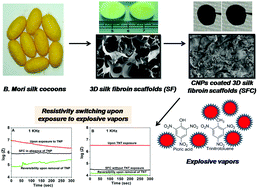Silk fibroin–carbon nanoparticle composite scaffolds: a cost effective supramolecular ‘turn off’ chemiresistor for nitroaromatic explosive vapours†
Abstract
The detection of nitroaromatic explosives is a pertinent issue with implications in homeland security, health and environmental monitoring. In this study, the development of a novel supramolecular bio-nanocomposite material based on Bombyx mori (B. mori) silk fibroin protein scaffold (SF) and carbon nanoparticles (CNPs) has been reported as a sustainable sensing platform for the nitroaromatic explosive vapours 2,4,6-trinitrophenol (TNP) and 2,4,6-trinitrotoluene (TNT). Herein, the sensing material is prepared via a static adsorption strategy involving non-covalent interactions, as evidenced from Fourier transform infrared (FTIR) spectroscopic studies, which demonstrate no change in the characteristic stretching frequencies of the carbon coated silk fibroin scaffold (SFC). Cross-sectional field emission scanning electron microscopy (FESEM) images suggest a thickness of CNPs of around 0.9 μm on the SF scaffolds. Further, Brunauer–Emmett–Teller (BET) analysis indicates multilayer adsorption of CNPs on the SF scaffolds. For sensing studies, carbon coated silk fibroin scaffolds are exposed to the vapours of TNP (SFCP) and TNT (SFCT) respectively followed by in-depth electrical analysis. Impedimetric analysis indicate changes in resistivity of the materials, following the order SF > SFC < SFCP, SFCT. The sensitivity of the biocomposite sensor has been investigated and found to increase by one order and two orders of magnitude when exposed to the vapours of TNP and TNT for 0–3 s, respectively. Further, the chemiresistive sensor is found to exhibit excellent reversibility, which is an important aspect from the point of view of recyclability of the sensor. In a nutshell, the use of low cost precursors, one pot approach for material development, utilization of impedimetric sensing technique, efficient sensitivity, excellent response time and reversibility make the system an ideal choice for sensing applications. Thus, the stated bio-nanocomposite might provide an excellent platform for the development of mechanically deformable and biodegradable systems, which has implications in the development of wearable electronics.


 Please wait while we load your content...
Please wait while we load your content...